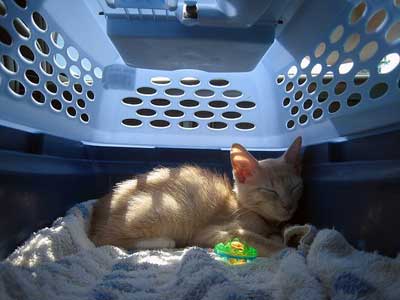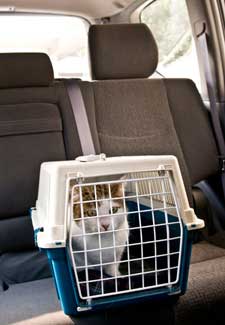Travel Cat Training For A Safe Journey
Cat Training Without Tears
Learning how travel cat training can ease the stress for both you and your cat, can be a worthwhile experience.
Some cats travel well, others, like some humans, really don’t like it.
But there are always going to be times where you may need to take your kitty on a journey.
If the cat is used to the situation before hand or at least feels safe, it is less likely that you will have to face the consequences of a sick cat.
Mo, a journey and the pukey result.
When we first brought Mo home with us we had no idea about her background and did not know how she would react to the car journey home.
Travel cat training had never even entered our heads before, but we soon realised that it would be something we would have to seriously think about.
Lets just say that Mo does not travel well and the sight of her shaking and cowing in her carrier is very distressing. Not to mention very messy when she is sick as well.
Unfortunately Mo has not been a well cat throughout her life and she has had to take many trips to the vets. So travel cat training was high on our list when we realised that it just wasn’t fair to Mo to keep putting her through a traumatic experience every time. The quicker we could provide her with a travel cat training routine and make her feel safe and secure the better.
Part 1- The Travel Cat Training Process

The Carrier
Most cats associate their carrier with a bad event, like a trip to the vets. So an important step in the travel cat training process is to get them to associate the carrier with a comfortable, safe place to be.
- Step 1. - put the carrier in the cats main living area and leave it there with the door open. Let the cat get used to it being there.
- Step 2. – Sleep with a towel for a few night to get your scent onto it and put that into the carrier with a few of their favourite toys.
- Step 3. - As the cat starts to get use to the carrier and the smells, put a few treats into it, to encourage them to enter the carrier. Gradually over a few weeks the cat will see the carrier as their own property and even start to use it to sleep in.
- Step 4. – when the cat is sitting in the box try to close the door but do not lock it. This way the cat will not feel trapped as they can push it open if they want to.Do this often until they seem less worried about the door being closed, at this point lock the door and see what their reaction is. If they panic open the door again. Repeat this process over weeks, until your cat is comfortable with the closed locked door.
Remember this is a slow process, if you try to rush it, all that will happen is the cat becomes even more afraid of the carrier and your problems could get worse. See our page about cat carriers here
Part Two - Travel Cat Training Part Two

The Car
- Step 1 - With your cat inside the carrier take it out to the car and sit with your cat, talking gently to it. Do this in 10 minute bites for a few days.
- Step 2 – Repeat step one but with the engine running.
- Step 3 – Drive around with your cat for short distances at first and then slowly increase the time as your cat gets use to the moving car.
Get used to taking your cat out regularly even if its only for a short time and always keep the carrier available for your cat to sit in and make it their own.
We found that as time went on, Mo became less and less afraid of the carrier and even though she still doesn’t really like travelling in the car, she now seems to be calmer than she used to be, and we have far fewer throwing up incidents.
Travel Cat Training Safety Tips
Tip 1 -When travelling with a cat in a car it is best to make sure the cat is contained in secure carrier which is tethered to the seat with a seat belt. There have been stories of cats who were allowed to wander round the car freely, getting thrown quite badly and injured when the car had to break suddenly.
Remember they are much lighter than us and act as a brick would if thrown through your windscreen. They could even hurt you quite badly.

Tip 2 – Always make sure your cat has a name tag on when travelling. I once temporarily lost a cat when taking them to the vets. The catch on the carrier broke and the lid flew off when I was carring it to the car.
It was a busy main road and kitty sped off like lightening. Luckily she was found and we were called to pick her up. If she hadn’t had her nametag on then we may have never seen her again.
Tip 3 – If you are on a long journey with your cat then remember to take regular rest breaks for both you and your cat. Give them something to drink and a little food (not too much in case of sickness).
Tip 4 – You have two options for providing a safe place for your cat to relieve themselves. You can either bring along a cardboard box with some of your cats usual litter in and allow your cat to use it in the car, (be warned you may end up with a backseat full of cat litter afterwards if you're not quick enough to remove the tray), or you could buy a cat harness and let your cat out of the car to go outside.
If you do use a harness, it is best to train your cat with it before hand. We have also provided some advice for Leash training here.
Travel cat training is a kind thing to do for your cat as sometimes the trauma of travelling for them can be quite extreme, and by taking away the fear of the situation you will have a happy cat who will go with you anywhere.
Top of this Travel Cat Training Page





